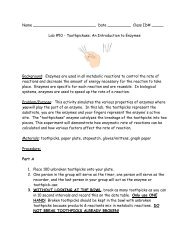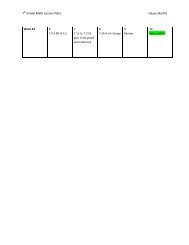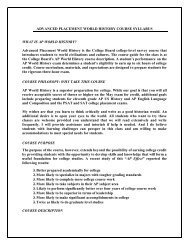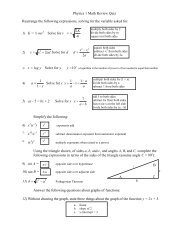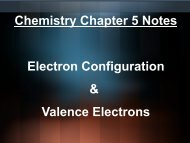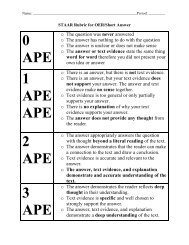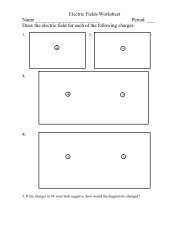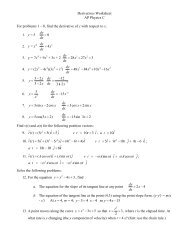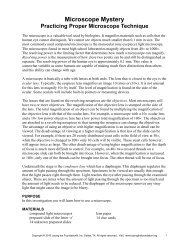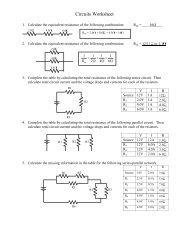Gases Review and Questions - pdf - Birdville Independent School ...
Gases Review and Questions - pdf - Birdville Independent School ...
Gases Review and Questions - pdf - Birdville Independent School ...
Create successful ePaper yourself
Turn your PDF publications into a flip-book with our unique Google optimized e-Paper software.
GASESTOF.I€.,10The ideal-gas equation is a way to calculate moles <strong>and</strong> is useful in solvingstoichiometry problems involving gas densities <strong>and</strong> molar mass. Masteringpartial pressures is essential in underst<strong>and</strong>ing the concepts of kinetics <strong>and</strong>equilibrium later in the course. Pay close attention to the effect of watervapor pressure on stoichiometry calculations. The kinetic molecular theoryis a valuable tool in explaining both the qualitative <strong>and</strong> quantitativemacroscopic behaviors of solids, liquids, <strong>and</strong> gases in terms of the interactionsof atoms <strong>and</strong> molecules. The gas laws, including Graham's law of effusion,are quantitative models that explain the behavior of gases. Pay close attentionto the interpretation of Figures 10.23 <strong>and</strong>I}.24for a qualitative underst<strong>and</strong>ingof the differences between ideal <strong>and</strong> real gases. only a qualitative knowledgeof the van der waals equation is important. Your study should focus on thefollowing sections:,|0.3 The Gos lows10.4 The ldeol-Gos Equotion,|0.5 Further Applicofionsilre ldeol Gos Equotion.|0.6 Gos Mixtures ond Portiol Pressuresl0.Z Kinetic Moleculor Theory,|0.8 Moleculor Effusion ond Diffusion,|0.9 Reol Goses: Deviotions from ldeol BehoviorPressure is the force that acts on a given area: Pressure : force/area. <strong>Gases</strong>exert a pressure on any surface in which they come in contact.Pressure Section10.2
168 TOPIC I OStondord pressure corresponds to a typicat pressure that the gases of theatmosphere exert at sea level. The SI value <strong>and</strong> unit for st<strong>and</strong>ard pressureare 1.01 x 10s Pascals.Pressure units most commonly used in chemistry <strong>and</strong> their relationships are:1 atm : 760 mm Hg : 760 torr : 1.01 x 105 Pa : LOL kPa.Sbndord temperoture is OoC : 273K.Section 10.3 The Gos lowsBoyle's law: the volume of a fixed quantity of gas at constant temperature isinversely proportional to the pressure.PrV : PzVFigure 10.1 graphically illustrates how the volume of a gas depends on thepressure at constant temperature.1.01.00.50.50L 0 1.0 2.0 3.0p' (a)U0.5 1.01ilt(b)Figure 10.1. Boyle's iaw states that the voluine of a gasdecreases with increasing pressure. (a) volume vs. pressure,(b) volume vs. 1/P.
GASES169lf the pressure of a fixed amount of gas doubles at constantemperature, whathappens to its aolume? Write your ansTlJer in the space proaided.Your Turn l0.lChorles' low: The volume of a fixed amount of gas at constant pressure isdirectly proportional to the absolute temperature.Yr/Tr: Yz/TzFigure 10.2 shows how volume decreases with decreasing temperafure.Notice how extrapolation of the graph to a theoretical zero volume gives thevalue of absolute zero temperature (0 K or -273C).a,nFigure 1.0.2. Charles' law states that thevolume of an enclosed gas increases withincreasing temperature. Extrapolation tozero volume yields the value of absolutezero.When the temperature of a fixed amount of gas doubles from 20"C to 40"C, whnthnppens to the aolume at constant pressure? Write your anslaer in the space proaided.Your Turn 10.2
170 ToPtc I 0Avogodro's hypothesis: Equal volumes of gases under the same conditions oftemperature <strong>and</strong> pressure contain equal numbers of molecules.Figure 10.3 shows that volumes of equal moles of gases at the same temperature<strong>and</strong> pressure are independent on the identity of the gas.Avogodro's low: The volume of a gas at constant temperature <strong>and</strong> pressure isdirectly proportional to the number of moles of the gas.Yt/nt:Yz/nzSince volume is directly proportional to moles, the coefficients that balancechemical equations for gas reactions can be taken as ratios of moles or liters atconstant temperature <strong>and</strong> pressure.Exomple:How many liters of water aapor can be obtained from the completecombustion of 24liters of methane gas? Assume temperature <strong>and</strong>pressure are such that all the water formed will be in the gas phase.Solufion:CH+(g) + 2o2@) --> Co2(g) + 2H2o(g)X2L/\L24L +?Lx liters HzO(S) : 24 L CH4 (2 L H2O / 1, L CHD : 48 L HzO(S)In what is sometimes called the combined gos lov/, aolume, temperature,<strong>and</strong> pressure aII change for a fixed amount of gas according to the followingequation:PlVr/Tr: P2Y2/T2Exomple:A weather balloon on the ground contains 25.8 L of He at 29"C <strong>and</strong> 741toru. What is the aolume of the balloon when it rises to an altitude wherethe temperature is 11.0oC <strong>and</strong> the pressure is 535 torr?H."fNz .: CHe .i.,.':i::'....:....,;t',1; .;i .,iVolume 22.1L !2.4L 22.4L..,.'..."Prei;sure latm latm latm'l emperature 0"L 0-(l {rC Figure 10.3. Avogadro's hypothesis:Mass of gas 4.il1 g 28.t) g 15.{l g Equal number of moles of any gas atNumber of 6.02 x 103 6.02 x 1tf] 6.02 x 1023 the same temPerature <strong>and</strong> pressuregas moleculesoccupy equal volumes.
GASESl7tSolution:This problem can be solaed by substituting ench aalue into the equation forthe combined gas lazu <strong>and</strong> solaing for V2. Keep in mind that the temperaturemust be expressed in Kelain, but the pressure can be in any suitable unitas long ss the units are consistent.PrVr/71 : P2V2/72(741torr)(25.8L)/(29 + 273 K) : (s35 torr)(V2)/(11 + 273K)Vz: 33.6 LAlternatiuely, the problem is solaed by conceptually applying Boyle's law<strong>and</strong> Charles's law to determine what happens to the aolume when the temperature<strong>and</strong> pressure change. The pressure goes down so the aolume goesup <strong>and</strong> the temperatule goes down so the aolume goes dozon.Multiply the original aolume by a ratio of pressures greater than one <strong>and</strong> aratio of temperatures less than one:V2:(25.8 L)x(741torr)/(535 torr)x(11+273 K)/ (29 +273 K):33.6 LThe ldeql-Gos Equotion.|0.4SectionThe ideol-gos equotion combines Boyle's, Charles's <strong>and</strong> Avogadro's laws:PV : NRTP : pressure in atmospheresV : volume in litersn : amount of substance in molesT : absolute temperature in KelvinR : 0.0821L-atm/mol-K.Common misconception: When using the ideal-gas equation, pressure,volume, amount of substance, <strong>and</strong> temperafure must always be expressedin atmospheres, liters, moles, <strong>and</strong> Kelvin respectively, when the constant Rhas those units. In the other equations, volume <strong>and</strong> pressure may beexpressed in any units as long as they are consistent.
172 TOPIC I OAn ideol gos is a hypothetical gas whose pressure, volume, <strong>and</strong> temperaturebehavior is completely described by the ideal gas equation.Common mirconception: No gas is an ideal gas. All gases are real gases.Howeveq, at temperafures at or above 25"C <strong>and</strong> pressures at or below oneatunosphere, genlrally mast rea] gases behave ideally.Section 10.5 Further Applicotions of ihe ldeql Gos EquotionThe ideal gas equation is useful in stoichiometry calculations involving gases.Exomple:Gasoline is a mixture of many hydrocarbon compounds but its chemicalformula canbe approximated as CsHB. How many liters of carbon dioxidegas are formed at 25.0'C <strong>and</strong> 7L2 torr when 1.00 gallon of liquid gasolineis burned in excess air? Liquid gasoline has a density of 0.690 g/mL. Onegallon is 3.80 L.Solution:First write <strong>and</strong> balance an equation. Then calculate the number of moles ofCO2using the mole road. FinaIIy use the ideal gas equation to conaertmoles of CO2to aolume in liters at the giaen temperature <strong>and</strong> pressure. Besure to conaert oC to K <strong>and</strong> torr to atmospheres.2CSt,,0 + 25O,(g) --> 16CO,(g) + 18H,O0)1 gallonx I s.so r/gatYIiters, I ago nttv"Srams*lnl g/mol x 16 mol,trob -,\. mol COz:2 mol?LV = nRT/Pm-ols = n1.00 gal(3.80 L/ gal)(690 g/ gal)(1, mol /1149)(16 mol COz/2mol CsHffi) : 184 moles CO2.
GASES17'.l,V : nRT/P :(Lu mol)(0.0821 L-atm / mol-K)(25 + 273 K) /(712 torr /760 torr / atm) : 4810 t.The density of a gas at any gia:en temperature <strong>and</strong> pressure is directlyproportional to its molar mass:d : PM/RTwhere d is density in grams per liter <strong>and</strong> M is the molar mass in gramsper mole.Exomple:What is the density of sulfur dioxide gas at 35"C <strong>and</strong> 1270 torr?Solution:The molar mass of SO2is 64.0 g/mol. Use the equationfor density. Makesure temperature is in Kelain <strong>and</strong> pressure is in atmospheres.d: PM/RT :(1270 torr/760 torr/atm)(64.0 g/mol)/10.0821 L-atm/mol K x(35 + 27gK)l: 4.238/L.Gqs Mixtures ond Portiol Pressures Section 10.6A porfiol pressure of a gas is the pressure exerted by an individual gas in amixture of gases. Water vapor pressure is a partial pressure.Dolbn's low of portiol pressures states that the total pressure of a mixture ofgases equals the sum of the pressures that each gas would exert if it werepresent alone. The equation is:Ptotul : Pl + P2 + P3 + "'
174 TOPIC I CTable 10.1. Some useful equations involving partial pressureEquotionCommenlsDolton's lowPtotal : P1 + P2 + P3 +' Ptotul : the total pressure of themixture, P1, P2 <strong>and</strong> P: : thepartial pressures of theindividual gases.Mole froction, X \: n1lnq nl : number of moles Of anindividual gas.n1 : total moles of gas.ldeol-gosequotionPortiolPressureP1 : nlRT/VP1 : (n1ln1)(P1)P1 : partial pressure of anindividual gas.nr : the number of moles ofthat gas.A convenient way to calculatepartial pressure from totalPressure.where Rotl is the total pressure of a mixture of gases <strong>and</strong> P1, P2, arrd P3 arethe portiol pressures of the individual gases in the mixture.The mole froction of a gas in a mixture is the ratio of moles of that gas to thetotal moles of gas in the mixture. X1 : n1/n1.Each gas in a mixture of gases behaves independently of all the other gases inthe mixture. Hence, each ideal gas in a mixture obeys the ideal gas law <strong>and</strong>all other gas laws. Each gas can be treated separately from the other gases inany mixture. Thble 10.1 summafizes some equations that are useful in partialpressure calculations.Exomple:Amixture of 9.00 g of oxygen,18.0 g of argon, <strong>and</strong> 25.0 grams of carbondioxide exert a pressure of 2.54 atm. What is the partial pressure of argonin the mixture?Solution:First calculate the number of moles of each gas. Then calculate the molefraction of argon <strong>and</strong> multiply it by the total pressure to get the partialpressure of argon.Moles of oxygen : 9.00 g/32.0 g/mol : 0.281 mol 02.Moles of argon: 18.0 g/39.9 g/mol: 0.451 mol Ar.
GASES17sMoles of carbon dioxide : 25.0 g / M.0 g / mol : 0.568 mol CO2.Mole f raction of Ar : XA, : moles of Ar / total moles of gases :0.451./(0.281 + 0.451 + 0.568) :0.451,/I.30 :0.347.Partialpressure of Ar : PAr : (Xe)(P) : 0.347 x 2.54atm: 0.88'1, atm.For convenience in the laboratory gases are often collected by bubbling themthrough water. This process causes the collected gas to be "contaminated"with water vapor. That is, the collected gas <strong>and</strong> the water vapor both exerttheir own partial pressures. The total pressure inside the collection vessel(usually the atmospheric pressure) is equal to the combined partial pressuresof the gas <strong>and</strong> the water vapor.Ptotal:Pgur*PwaterExomple:Hydrogen is produced by the action of sulfuric acid on zinc metal <strong>and</strong>collected oaer water in a 255 mL container at 24.0oC <strong>and</strong> 718 torr. Theaapor pressure of water at 24"C is 22.38 torr. How many moles ofhydrogen gas are produced <strong>and</strong> how many grams of zinc react?Solution:First, write <strong>and</strong> balance an equation. Then subtract the uapor pressureof water (giaen in the question or obtained from Appendix B ofChemistry the Central Science)y'om the atmospheric pressure toobtain the partial pressure of hydrogen gas. Finally, calculate thenumber of moles of hydrogen using the ideal gas equation. Any timeyou use the aalue of R, be sure to conuert pressure to atmospheres <strong>and</strong>aolume to liters.Zn(s) + 2H+(aq) --> Zn2+(aq) + HzG),rr:Patm - Putater:718torr - 22.38torr:696torrnH2PV / RT : (696 torr /760 torr/ atm)(0.255 L) /(0.0821 L-atm/mol-K)(24 + 273 K) : 0.00958 mol H2The balanced equation tells us that the number of moles of hydrogenproduced is equal to the number of moles of Zinc reacted.x g Zn : 0.00958 mol Zn x 65.4 g/mol : 0.627 g.
176Section l0.Ztor,. I 0Kinetic-Moleculq r TheoryKinetic-moleculor theory is a model that explains the macroscopic behavior ofgases at the atomic <strong>and</strong> molecular level. The following statements summarizethe model for an ideal gas:1. <strong>Gases</strong> consist of atoms or molecules in continuous, r<strong>and</strong>om motion.2. The volume of the gas particles is negligible relative to the volumeof their container.3. Athactive <strong>and</strong> repulsive forces between gas particles are negligible.4. Collisions between gas particles <strong>and</strong> between gas particles <strong>and</strong> theircontainers are perfectly elastic (they happen without loss of energy).5. The average kinetic energy of particles is proportional to theabsolute temperature.Pressure of a gas is caused by the collisions of the gas particles with the wallsof their container. The magnitude of the pressure is related to how often <strong>and</strong>how forcefully the particles strike the walls.The absolute temperature of a gas is a measure of the average kinetic energyof the particles. Molecular motion increases with increasing temperafure.The kinetic-molecular theory explains the gas laws at the molecular level.For example, if the volume of a fixed amount of gas is increased at constanttemperature, the container walls have a larger surface area. Thus, the pressuredecreases because there are fewer collisions per unit time per unit area onthe walls of the container.Increasing temperafure of a fixed amount of gas at constant pressure increasesthe average kinetic energy of the molecules. Thus, the increased frequency<strong>and</strong> energy of collisions with the container have the effect of pushing backthe walls of the container exp<strong>and</strong>ing the volume.Your Turn 10.3Use kinetic-molecular theory to explain why when the temperature of a fixedamount of gas increases, the pressure increases. Write your answer in the spaceproaided.
GASESMoleculor Effusion qnd Diffusion177.|0.8SectionEffusion is the escape of gas molecules through a tiny hole into an evacuatedspace.Diffusion is the spread of one substance through space or through anothersubstance.Grohom's low of effusion states that the effusion rate of a gas is inverselyproportional to the square root of its molar mass. The equation for Graham'slaw relates the ratio of effusion rates of two gases to the ratio of the squareroot of their molar masses:rt/rz:(Mz/M)r/2Common misconception: The roie at which a particular gas effusesisinversely proportional to the time. it takes that gas to effuse. Rate isoften expressed in moles per unit time.Exomple:At a particular temperature <strong>and</strong> pressure, neon gas effuses at a rate of16.0 mol/s.a. What is the rate at which argon ffises under the same conditions?b. Under a different set of conditions, 3.0 mol of argon effuse in 49.0seconds. How long will it take an equal amount of helium to effuse?Solution:a. Substitute the giaen information into the equation for Graham's law.rAr/rNe :(MNr/ Ma)1/2ra,/16.0 : (20.2g/mol/39.9 g/mot)\/2.rn : I1..4mol/s.b. Time is inaersely proportional to the rate so the equation becomes:Tur/Ta, : (Mur/ Ma)1/2THe/49.0 s : (4.00 g/mol/39.9 g/mol)I/2.TH, : 15.5 s.
178Section 10.9tor'. I 0Reol Goses: Deviotions from ldeql BehoviorReal gases differ from ideal gases largely because the volumes of real gas particlesare finite <strong>and</strong> their attractive forces <strong>and</strong> repulsive forces are nonzero.A real gas does not behave ideally at high pressure because the finite volumeof its particles is significant compared to the volume of its container. Alsoattractive forces come into play at short distances when gas particles arecrowded together.A real gas does not behave ideally at low temperature because its nonzeroattractive forces are significant at low kinetic energy. Eventually as thetemperature (average kinetic energy) drops, attractive forces cause the gasto condense to a liquid.Deviations from ideal behavior for gases generally increase with increasingmolecular complexity <strong>and</strong> increasing mass. Mass is directly related to molecularvolume, <strong>and</strong> molecular complexity is associated withbothvolume <strong>and</strong> athactiveforces.The van der Waals equation predicts the behavior of real gases under conditionsof low temperature <strong>and</strong> high pressure by employing correction factors for finitevolume <strong>and</strong> attractive forces.P : nRT/(V-nb)correction for volumen2a/Y2correction for attractive forcesThe constants a <strong>and</strong> b are correction factors for molecular attraction <strong>and</strong> volume,respectively, <strong>and</strong> n is the number of moles. Table 10.2 gives van derWaals correction factors for common gases.Table 10.2. Van der Waals constants for gas moleculesSubstance a (L2-aunlmol2) b (L1mol)HeNeArKrXeH2N2O2ClzHzoCHaCozccl40.03410.2111.342.324.190.2441.391.366.495.46/..233.5924.40.023744.01714.03220.03980.05100.02660.03910.03180.05620.03050.04284.04270.1383
GASESt79which of the noble gases will deaiate the most from ideal behaaior? Explain yourreasoning. Write your answer in the space proaided.Your Turn 10.4Table 10.3. Summary of the gas laws <strong>and</strong> their equationsGos lowStotemenlQuontities thotore consiontEquotionBoyle's llowThe volume of a fixedquantity of gas atconstant temperatureis inverselyproportional to theflrTP1V1 : P2V2Pressnre.Chorles'lowThe volume of a fixedamount of gas at constantpressure is directlyproportional tothe absolutetemperature.flrPY1/T1: Y2/T2Unnomed LowThe pressure of afixed quantity of gasat constant volume irdirectly proportionalto the absolutetemperafure.nrvh/Tr: Pz/TzCombined GosLowCalculates the effecton temperafure,pressure/ or volumewhen the other h,voare changed for afixed amount of gas.PrYt/Tt:P2Y2/T2
8o tor,. I 0Table 10.3. Summary of the gas laws <strong>and</strong> their equations (continued)Gos lowSlotementQuontifies thotore consiontEquotionAvogodro's LowThe volume of a gasat constant temperature<strong>and</strong> pressure isdirectly proportionalto the number ofmoles.T,PYr/nt - Yz/nzldeolGos lowCombines the abovelaws into oneequation.R : 0.0821L-atm/mol KPV:NRTGrohom's lowof EffusionThe effusion rate ofgases is inverselyproportional to thesquare root of theirmolar masses.\/rz:(Mz/M)1/2Dqlton's Low ofPortiolPressuresThe total pressure ofa mixture of gasesequals the sum ofthe partial pressureof each component.Pt:Pr+P2+P3Your Turn 10.5Arrange the following gases in order of increasing deaiation from ideality:H2O, CHa, Ne. lustifu your answer. Write your answer in the space proaided.
116 a CunprEn5(Clcmisty & Clemial fth ed. pages 54}.543Ath ed. pages 534-537)The ideal gas model fails at high pressure <strong>and</strong> low temperature. Realgas molecules take up space <strong>and</strong> experience attractive forces betweenmolecules. At high pressure there is less empty space betweenmolecules, <strong>and</strong> the volume of molecules becomes more sigTnificant. Anideal gas could be compressed to zero volume, but for a real gas, asthe pressure doubles, the volume of empty space cannot continue to behalved. As the temperature decreases, the molecules have less kineticenergy to overcome the attractive forces between gas molecules; theseattractive forces may cause the gas to condense.The van der Waals equation modifles the assumptions of the kineticmolecular theory to fit the behavior of real gases.lPor" + a(n/V)2 1 "(V -nb) = nRTExlupu: 'vVhich of the following gases would you expect to havethe largest value of the van der Waals constant, b: Hz, N2, CHa,CzHo, or CgHs?The van der Waals constant, b, is a measure of the size of themolecule. CgHshas the largest molar volume <strong>and</strong> should have thelargest value of b.Exnvpu: Which of the following gases would you expect to havethe largest value of the van der Waals constant, a: Hz, COz, CH+,or Nz?COz has the lairgest value for a, which measures intermolecularattractions. All the molecules are nonpolar so the only forcepresent is an induced dipole or London force which increases asthe number of electrons <strong>and</strong> protons in the molecule increases.flhis will be discussed in Chapter B.)No calculators are to be used in this section.7. Ideal gases vary from real gases at conditions of(A) high temperature <strong>and</strong> low pressure.(B) high temperature <strong>and</strong> high pressure.(C) low temperature <strong>and</strong> low pressure.(D) low temperature <strong>and</strong> high pressure.(E) both high density <strong>and</strong> low pressure.@ 2012 Cengagel*aming. All Rights Reserued. May not be copied, scanned, or duplicated, in whole or in part, exc€pt for use as permitted in a licensedistributed with a certain product or seryice or othemise on a pmsword-protect€d website for classtoom use.
t.Gesss + 7172. What is the volume of 3.00 mol of gas @ STP?(A) 22.4L(B) 3 x 22.4L{C}3x22.4Lx760' (D) 3 x 22.41L x'273 / 760(E) It cannot be determined without knowing which gas is involved.3. An ideal gas of volume 189. mL is collected over water at 30"C <strong>and</strong>777 torr. The vapor pressure of water is 32 torr @ 30pC. Whatpressure is exerted by the dry gas under these conditions? '(A) 320 torr(B) 745 torr(C) 777 torr(D) 32 / 77 torr(E) 32 x777 torr4. A 14.0-L rylinder contains 5.60 g N& 79.9 g Ar <strong>and</strong> 6.4O g Oa. Whatis the total pressure in atn at27"C? (R = the ideal gas constantJ(A).20R(B) 26 R(c) 30 RtD) 60 R(E) 120 R5. In a closed inflexible system, 7.0 mol COz, 7.0 mol Ar, 7J mol Nz,<strong>and</strong> 4.0 mol Ne are ffappe4 with a totd pressure of 10.0 atrn. Whatis the partial pressure exerted by the neon gas?(A) 1.6 annG) 4.0 aun(C) 10.0 atrn(D) 21.0 aun(E) 29.0 atrn6. Consider the reaction: CzFIo(g) + 7 /2 Oz{gl ) 2COz(g) + 3H2O(g}. If6.0 g ethane, CeIIs(g) burn {as shown above), whatvolume of COdg)will be formed at STP?(A) 0.20 L(B) 0.40 L(c) 2.2L(D) 9.0 L(E) 22.4L7. Clz <strong>and</strong> Fz iombine to form a gaseous product one volume of Clzreacts with three volumes of Fz yielding two volumes of product.Assuming constant conditions of temperature <strong>and</strong> pressure, what isthe formula of the product?(A) CIF(B) ClzFz(C) ClFz(D) ClzF(E) CIFSO 2012 Ccn$$ I.crtuiq. An Rigtdr Rcrcrved. fv{aynot bccopiod, scaooEordiplio@4 in wWcinplt, dc.ft ftaraapcenitbd iaalicoorcdirtrihod ryi|h accrtrin prcdrctqlcffiocor otkwis. od sprsswoidti@dwchla frrchrsomrsc,
a118 n Gnprrn58. Decreasing the temperature of an ideal gas from soc to 4oeccauses the average kinetic energy to(A) decrease by a factor of two.(B) decrease by a factor of four.(C) increase by a factor of two.(D) increase by a factor of four., (E)tdecrease by less than a factor of two.9. The eftrsion rate of helium gas, He, compared with that of methanegas, CHa, is(A) four times grreater for helium.(B) four times less for helium.(C) twice as great for helium.(D) twice as great for methane.(E) sixteen times hs gneat for helium.10. The average speed of the molecules of a gas is proportional to the(A) volume of the container.(B) reciprocal of absolute temperature, 0 / D.(C) absolute temperature.(D) square root of the absolute temperature.(E) square of the absolute temperature.11. Nitrogen gas diffirses through a porous barrier at the rate of 5.8Oliters per minute. An unknowri gas under the same conditionsdiftrses through the same barrier at a rate of only 1.80 liters perminute. What is the molar mass of the unknown gas?(A) 45.1G) 50.3(c) e0.3(D) 145(E) 29172. A 5.0 L vessel contains 2.0 moles of helium <strong>and</strong> 3.0 moles ofhydrogen at a pressure of 10 atni. t"taintaining a constanttemperature, an additional3.0 moles of hydrogen are added. What. is the partial pressure of hydrogen gas in the vessel at the end?(Assume that the gases behave ideally.)(A) 6.0 atm(B) 8.0 atm(C) 10.0 atrn(D) 12.0 atm(E) 20.0 annO 2012 Ccnglge lr.miry. All Rights Rcccrvcd" Mcy not bc copi.4 seanoc4 or duplicate4 in wblc c ir p.ri, c*ccpt fa us. as pcrmitbd ia a liccnsedistribuilodwilh rccrEin go&rf orrrrvicc ordkrviEc on r pg63word-prc6cEd wobaite forchrsro@usc.
Geses . 119<strong>Questions</strong> 13-15 refer to Figrure 1 <strong>and</strong> Figrdre 2 below. On the righi is akey to identiff the gases in the problems.Figrure 1 Figure 2 Key to Gas Symbols^" -oo .-o o oOooooo;;?lr:ijGas AGas BGas CGas DOoo13. In Figrure l there are three gases present, gas A, B <strong>and</strong> C. Thenumber of spheres represents the number of moles of each gaspresent. If the total pressure within the vessel is 5.00 atm, what isthe partial pressure of gas B?(A) 0.500 atn(B) 1.00 atrn(C) 1.33 atrn(D) 1.50 atm(E) 1.67 atm74. Suppose that another gas D is added to the vessel in Figrure 1,keeping the temperature <strong>and</strong> the volume constant. This isrepresented byFigure 2 above. What hdppens to the partialpressure of gas B?(A) increases(B) decreases(C) stays the samd15. What happens to the total pressure for the system described inQuestion 74? (ln other words, compare the total pressure in Figure1 versus Figure 2).(A) increases(B) decreases(C) remains the sameCalculators may be used for this section.1. (a) Compare the temperature of fresily tnade coffee made at loweraltitudes to coffee made at higher altitudes. Support your(b) flYfl"fiP"$:'ffi":#n. (p + a/v)(v -b)= nrr, is anecessary form of PV= nRTunder certain conditions.i. What are these conditions? Explain yorr answer.02012 Ccng4c L,crrniq. All RighsRdcwed. May notbc copid scanncd, or duplioatd in wholc o in prr{ cxcept forre rr pcrrdttod in a liccnrcdistibutcd wi$ a ccrtain pro&rct or scrvicc or ottcrwisc on I p.rsn'od-p(dcstcd wcboitc fccbssroom u3c.
120 .:. CHapren 5ii. What are the physical properties which the constants"a"<strong>and</strong>"b" are desigined to describe? Explain your answer.(c) Explain on a molecular level why gases exert pressure.(d) How does gaseous pressure relate to changes in volume?Explain.2. Assume that two cylinders at 27"C are connected by a closedstopcock (valve) system. The right-h<strong>and</strong> cylinder contains 2.4 L ofhydrogen at 0.600 atm; the left cylinder is larger <strong>and</strong> contains 6.8 Lof helium at 1.40 atm.(a) How many moles of each gas are present?(b) What is the total pressure when the valve is open?(c) Determine the partial pressure of,these two gases at27"Cwhen the stopcock is opened.AnswersMulrpu Cnorce1..D At low temperature <strong>and</strong> high pressure, the molecules arecloser together <strong>and</strong> therefore the forces between moleculesbecome more important as they are stronger. The actual (finite)volume of individual molecules also becomes more importantas more of the total space is actually occupied by finitemolecular volume (Chemistry & Chemical Reactivity 7th ed.pages 542-543/Bth ed. pages 534-537).2.3.4.5.6.B The molar volume of all gases at STP is about 22.4 L, so threemoles would occupy 22.4 L /mol x 3 moles {ChemisW &Chemical Reactivity 7th ed. page 529/Bth ed. page 519).B The total pressure = 777 torr. Of this, 32 torr is due to thewater vapor, hence 777-32 = 745 torr of pressure are allocatedto the dry gas (Chemistry & Chemical Reactivity 7th ed. pages530-532/Bth ed. pages 524-527).C Use Protur = NroturRT / V to determine the pressure. From themass of each of the gases you can flnd 0.200 mol of Nz, 1.00 molof Ar, <strong>and</strong> 0.200 mol of Oz to give a total number of moles (n) of1.4mol. ThereforeProt"r= R x 1.40mol x 300K / 74.0 L= 30R.Note: You do not need a calculator to divide 7.4 by 14 <strong>and</strong> thenmultiply by 300! (Chemistry & Chemical Reactivity 7th ed. pages524-525/Bth ed. pages 518-519).A The total number of moles is 25 (7.0 + 7.0 + 7.0 + 4.O = 25),hence the Ne is 4 /25 of the total amount of gas <strong>and</strong> exerts 4 /25of the total pressure, or 4/25 x 10 atm = 1.6 atm (Chemistry &Chemical Reactivity 7th ed. pages 530-532/Bth ed. pages 521-527).D 6.0 g of ethane / 30. g/mol yields 0.20 mol of ethane, whichforms twice that number of moles of carbon diodde. Since onemol of gas occupies 22.4 L at STP, 22.4 Umol x 0.20 mol x 2@ 2012 Cengage Learning. All Rights Reserved. May not be copied, scanned, or duplicated, in whole or in part, except for use as permitted in a licensedistributed with a certrain product or seruice or othemise on a password-protected website for classroom use.
AP <strong>Gases</strong> <strong>Review</strong> Answer DocumentMC1. _____2. _____3. _____4. _____5. _____6. _____7. _____8. _____9. _____10. _____Name ____________________________11. _____12. _____13. _____14. _____15. _____FR_________________________________________________________________________________________________________________________________________________________________________________________________________________________________________________________________________________________________________________________________________________________________________________________________________________________________________________________________________________________________________________________________________________________________________________________________________________________________________________________________________________________________________________________________________________________________________________________________________________________________________________________________________________________________________________________________________________________________________________________________________________________________________________________________________________________________________________________________________________________________________________________________________________________________________________________________________________________________________________________________________________________________________________________________________________________________________________________________________________________________________________________________________________________________________________________________________________________________________________________________________________________________________________________________________________________________________________________________________________________________________________________________________________________________________________________________________________________________________________________________________________________________
____________________________________________________________________________________________________________________________________________________________________________________________________________________________________________________________________________________________________________________________________________________________________________________________________________________________________________________________________________________________________________________________________________________________________________________________________________________________________________________________________________________________________________________________________________________________________________________________________________________________________________________________________________________________________________________________________________________________________________________________________________________________________________________________________________________________________________________________________________________________________________________________________________________________________________________________________________________________________________________________________________________________________________________________________________________________________________________________________________________________________________________________________________________________________________________________________________________________________________________________________________________________________________________________________________________________________________________________________________________________________________________________________________________________________________________________________________________________________________________________________________________________________________________________________________________________________________________________________________________________________________________________________________________________________________________________________________________________________________________________________________________________________________________________________________________________________________________________________________________________________________________________________________________________________________________________________________________________________________________________________________________________________________




